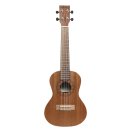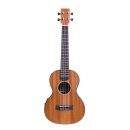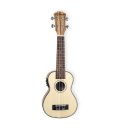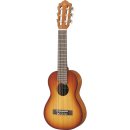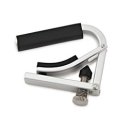Ukuleles
We carry many different ukulele types Scroll down to see the full range or select a ukulele type below. Read our guide to choosing a ukulele
Categories
 Keyboards & Pianos
Keyboards & Pianos
 Guitars
Guitars
 Bass
Bass
 Amplifiers for Instruments
Amplifiers for Instruments
 Drums
Drums
 Percussion
Percussion
 Instruments for Kids
Instruments for Kids
 Music Stands
Music Stands
 Music Stand Lights
Music Stand Lights
 String Instruments
String Instruments
 Wind Instruments
Wind Instruments
 Banjos
Banjos
Ukulele
Read about different ukulele types here:
How do I choose the right ukulele?
The first thing you need to decide is what size ukulele you need. The most common is a soprano ukulele, but a concert ukulele is also worth considering - especially if you're an adult, as there's more room for your fingers on the fretboard. Another advantage of a concert ukulele is that the larger body provides a fuller sound and slightly higher volume.
Once you've decided on size, you'll need to decide on a price range. The cheapest models are fine to start with, but if you want better sound and playability, it's worth moving up to the mid-range. Another feature you might need is built-in pickup - the ability to connect your ukulele to an amplifier or speaker system - or record it on your computer.
Last but not least, you need to choose which color you want. Ukuleles come in every color of the rainbow, so there's plenty to choose from - and for the price, you can almost afford to have two!
What exactly is a ukulele?
A ukulele is a four-stringed musical instrument made of wood that looks like a small classic Spanish guitar, only smaller. It has fewer strings and a simpler tuning and playing technique. The ukulele produces a unique and distinctive sound that immediately brings to mind tropical surroundings.
The ukulele is a Hawaiian stringed instrument consisting of 4 strings. Its appearance is very similar to a guitar, with a body that forms the resonance chamber and a sound hole that acts as an acoustic amplifier. Along the body is a neck, called the fingerboard, and at the end of the fingerboard are fire tuning screws, which are used to tune the ukulele. The ukulele has nylon strings, which are soft to play and won't cause sore fingers if you're a beginner.
How do you play the ukulele?
If you've been to concerts and watched musicians play stringed instruments, you'll already have a good understanding of how to play the ukulele. Along the neck of the ukulele are frets between which you can place your fingers to create different notes or chords. The strings can be struck with your thumb, a pick, or you can play fingerpicking where each string is played separately.
Watch the video below for some tips and tricks on how to play a ukulele:
Differences between an expensive and a cheap ukulele
Ukuleles come in a myriad of colors, shapes, sizes and price ranges. So what's the difference? Common to all is the relatively small size that allows even a child's hand to reach around the neck and play chords on the fretboard.
The body of the ukulele is made of veneer/laminate, the neck is made of solid wood, usually mahogany, and hard plastic for tuning screws, bridge and the like. Our ukuleles are of the same high quality, so the price usually depends on the size and type of ukulele.
How do I choose the right ukulele?
You need to choose a ukulele that suits you, both the shape and color combination should be right on target.
Of course, besides looks, the sound plays the most important role. You can choose an electric ukulele that can be connected to an amplifier or an acoustic ukulele. With the acoustic ukulele, the larger the ukulele body, the more resonance and therefore sound can come out of it. Take a look at the video below from YouTube to hear the different types of ukuleles. You'll be much better equipped to make the right choice and buy the ukulele that suits you best.
History of the ukulele
The ukulele is a traditional Hawaiian stringed instrument that is part of the lute family.
The ukulele has been around for hundreds of years, but only in the last 10 years has it gained huge popularity around the world. The instrument's function as a kind of beginner's guitar has made the ukulele very popular, as it is easier and more accessible than a traditional guitar. Over time, there have been several types of ukuleles, as well as a myriad of models with different shapes, embellishments, sizes, number of strings and the like.
Different ukulele types
The different ukulele types have one thing in common: they all have 4 strings, with the exception of the 8-string ukulele. The size and tuning, how the ukulele is tuned, can vary between the different ukuleles.
Below you can see an overview of the different ukulele sizes and how they are tuned. As mentioned, there are many different types and the most commonly known are these:
Sopranino ukulele
The Sopranino ukulele is the smallest of the family with a length of only 32-41 cm. This model dates back to 1990 and is still incredibly popular today. The small size gives the instrument a penetrating sound that stands out beautifully in larger ensembles or bands. The sopranino is tuned: DGHE and is therefore the highest sounding in the ukulele family
Soprano ukulele
The soprano ukulele is the classic ukulele, also known as the standard model. Since then, more have been added, but the soprano model is still the most commonly used. The soprano model has a length of 53 cm, which also gives the characteristic slender sound, where the strings' impact together with the body's resonance chamber create the sound. The soprano model is tuned GCEA or slightly higher ADF#H, depending on how soft/hard you prefer your strings.
Concert / Concert ukulele or alto ukulele
The concert or alto ukulele is widely used together with the soprano ukulele. The concert ukulele has a length of around 58 cm and is only a few centimeters larger than its soprano little brother. They are also tuned the same, so the strings on the concert ukulele are GCEA/ADF#H, again depending on how loose or tight you prefer your strings. For example, for fingerstyle playing, tight strings can have an advantage, as it's easier to pluck the strings with a pick or your fingers. Conversely, if you play big chords and strike all strings, a loose tuning of the instrument can produce more sound.
Tenor ukulele
The tenor ukulele is the most commonly used model by professional musicians. Measuring 66 cm from the bottom of the body to the end of the neck, the tenor model offers more options due to its size. The tenor ukulele has a large body and thus a large resonance chamber which gives it a soft sound and, unlike the previously mentioned models, less sound from the strings being struck. The tenor ukulele is tuned: GCEA/ADF#H and with a length of approx. 66 cm, it has a sound very similar to a Spanish/classical guitar.
Baritone ukulele
The baritone ukulele is the largest in the ukulele family, before the bass and double bass models. The baritone model is tuned :DGBE which gives a deep, soft and rounded sound that, like the tenor model, is very similar to an acoustic guitar. The baritone ukulele has a length of about 74 cm, which is necessary so that the low notes of the strings can be amplified in the body's large resonance chamber. This model is less common but is a great instrument with a long sustain, round tone and lots of possibilities
Bass and double bass ukulele
The bass and double bass ukulele only have the ukulele shape and appearance in common. This model stands out because it is tuned like a regular bass, or like the 4 thickest strings on a guitar. The bass and double bass ukulele is tuned: EADG and is therefore played in the same way as a regular bass. The strings are made of nylon and elastin, which gives a "rubbery" surface. This also characterizes the sound, which has a "dump fishing cutter" like sound, which with a little imagination can be compared to Poul McCartney's sound from all Beatles records, where he plays his Hˆfner Violin bass. Measuring from 76 cm to 82 cm, these models have the largest resonance chamber, which is important for amplifying deep bass tones.
Electric ukulele
Electrically amplified ukuleles are available in all of the above models. The key feature of electric models is the built-in pickup that can amplify the signal beyond the instrument's own resonance chamber. These pickups can be either contact microphones that pick up vibrations and oscillations or a microphone pickup that captures and reproduces the sound. Electrically amplified ukuleles don't require a special amplifier, but can be plugged into a guitar amplifier or PA system (vocal system) and are great in the rehearsal room where amplification is needed.
Guitar harpsichord
Like the bass and double bass models, the guitar harp has crept into the ukulele family. A guitar harp is really just a small guitar that is even smaller than the travel guitar or 3/4 guitar that children use. The advantage of the guitar harp is that you can practice chords, fingerings and fingerings and easily transfer them directly to a regular guitar. The guitar harness can be tuned and played just like a regular guitar, making it great for traveling, trips and the like where a regular guitar can't go.
A couple of other stringed instruments that might also be considered "related" to the ukulele are a banjo and a mandolin
Beginner ukulele and ukulele for kids
If you're new to the ukulele or need to buy a ukulele for your child, we have SoundstoreXL we have a wide selection. For children, a soprano ukulele is a great choice, with a length of around 53 cm, making it one of the smaller ukuleles. This has the immediate advantage that the fingerboard, on which the fingers play chords, is narrow and thus easy to handle even for a child's hand.
If you're an adult who wants to take up the ukulele, the size of the ukulele's neck will never be a problem. Therefore, choose based on color, shape, size and watch the previous video where the different ukulele types are reviewed.
Listen to "Jake Shimabukuro", perhaps one of the world's best on a ukulele
Read more about ukulele on Wikipedia: click here or here



